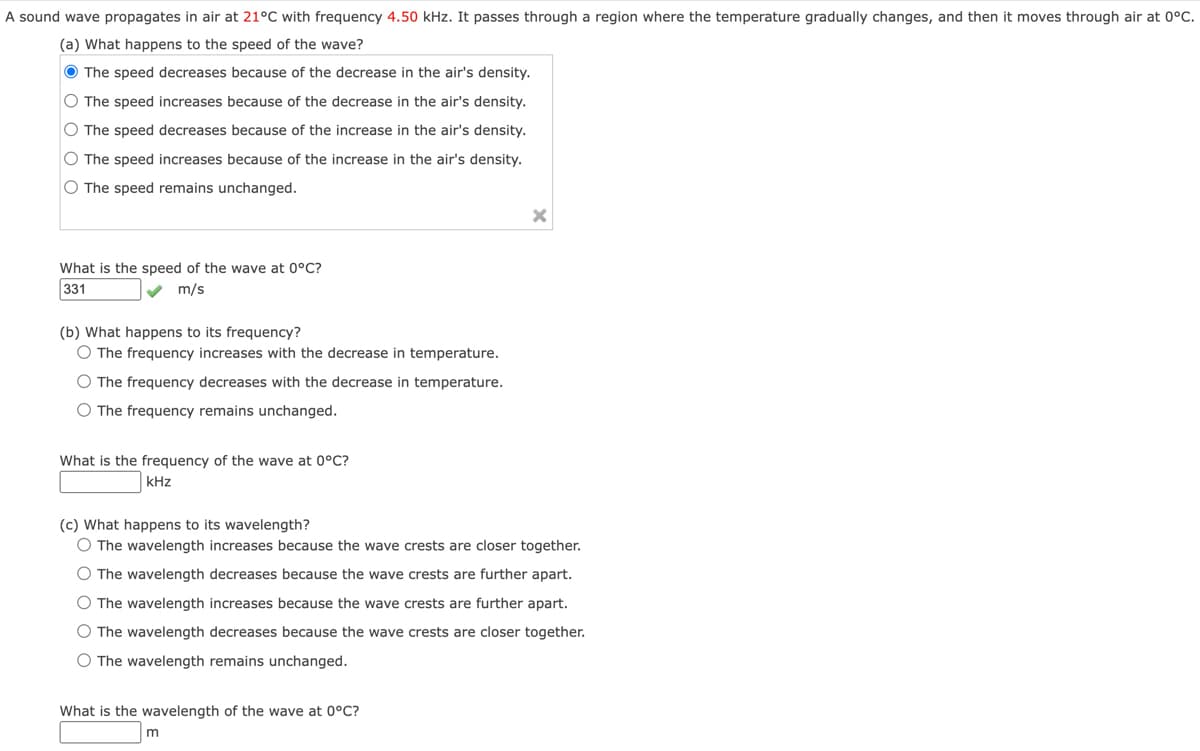A sound wave propagates in air at 21°C with frequency 4.50 kHz. It passes through a region where the temperature gradually changes, and then it moves through air at 0°C. (a) What happens to the speed of the wave? The speed decreases because of the decrease in the air's density. O The speed increases because of the decrease in the air's density. O The speed decreases because of the increase in the air's density. O The speed increases because of the increase in the air's density. O The speed remains unchanged. X What is the speed of the wave at 0°C? 331 ✓ m/s (b) What happens to its frequency? O The frequency increases with the decrease in temperature. O The frequency decreases with the decrease in temperature. O The frequency remains unchanged. What is the frequency of the wave at 0°C? kHz (c) What happens to its wavelength? O The wavelength increases because the wave crests are closer together. O The wavelength decreases because the wave crests are further apart. O The wavelength increases because the wave crests are further apart. O The wavelength decreases because the wave crests are closer together. O The wavelength remains unchanged. What is the wavelength of the wave at 0°C? m
A sound wave propagates in air at 21°C with frequency 4.50 kHz. It passes through a region where the temperature gradually changes, and then it moves through air at 0°C. (a) What happens to the speed of the wave? The speed decreases because of the decrease in the air's density. O The speed increases because of the decrease in the air's density. O The speed decreases because of the increase in the air's density. O The speed increases because of the increase in the air's density. O The speed remains unchanged. X What is the speed of the wave at 0°C? 331 ✓ m/s (b) What happens to its frequency? O The frequency increases with the decrease in temperature. O The frequency decreases with the decrease in temperature. O The frequency remains unchanged. What is the frequency of the wave at 0°C? kHz (c) What happens to its wavelength? O The wavelength increases because the wave crests are closer together. O The wavelength decreases because the wave crests are further apart. O The wavelength increases because the wave crests are further apart. O The wavelength decreases because the wave crests are closer together. O The wavelength remains unchanged. What is the wavelength of the wave at 0°C? m
Principles of Physics: A Calculus-Based Text
5th Edition
ISBN:9781133104261
Author:Raymond A. Serway, John W. Jewett
Publisher:Raymond A. Serway, John W. Jewett
Chapter13: Mechanical Waves
Section13.7: The Doppler Eff Ect
Problem 13.7QQ
Related questions
Concept explainers
Interference of sound
Seiche
A seiche is an oscillating standing wave in a body of water. The term seiche pronounced saysh) can be understood by the sloshing of water back and forth in a swimming pool. The same phenomenon happens on a much larger scale in vast bodies of water including bays and lakes. A seizure can happen in any enclosed or semi-enclosed body of water.
Question
a b and c

Transcribed Image Text:A sound wave propagates in air at 21°C with frequency 4.50 kHz. It passes through a region where the temperature gradually changes, and then it moves through air at 0°C.
(a) What happens to the speed of the wave?
The speed decreases because of the decrease in the air's density.
O The speed increases because of the decrease in the air's density.
O The speed decreases because of the increase in the air's density.
O The speed increases because of the increase in the air's density.
O The speed remains unchanged.
X
What is the speed of the wave at 0°C?
331
✓ m/s
(b) What happens to its frequency?
O The frequency increases with the decrease in temperature.
O The frequency decreases with the decrease in temperature.
O The frequency remains unchanged.
What is the frequency of the wave at 0°C?
kHz
(c) What happens to its wavelength?
O The wavelength increases because the wave crests are closer together.
O The wavelength decreases because the wave crests are further apart.
O The wavelength increases because the wave crests are further apart.
O The wavelength decreases because the wave crests are closer together.
O The wavelength remains unchanged.
What is the wavelength of the wave at 0°C?
m
Expert Solution
This question has been solved!
Explore an expertly crafted, step-by-step solution for a thorough understanding of key concepts.
This is a popular solution!
Trending now
This is a popular solution!
Step by step
Solved in 3 steps

Knowledge Booster
Learn more about
Need a deep-dive on the concept behind this application? Look no further. Learn more about this topic, physics and related others by exploring similar questions and additional content below.Recommended textbooks for you

Principles of Physics: A Calculus-Based Text
Physics
ISBN:
9781133104261
Author:
Raymond A. Serway, John W. Jewett
Publisher:
Cengage Learning

Physics for Scientists and Engineers: Foundations…
Physics
ISBN:
9781133939146
Author:
Katz, Debora M.
Publisher:
Cengage Learning

University Physics Volume 1
Physics
ISBN:
9781938168277
Author:
William Moebs, Samuel J. Ling, Jeff Sanny
Publisher:
OpenStax - Rice University

Principles of Physics: A Calculus-Based Text
Physics
ISBN:
9781133104261
Author:
Raymond A. Serway, John W. Jewett
Publisher:
Cengage Learning

Physics for Scientists and Engineers: Foundations…
Physics
ISBN:
9781133939146
Author:
Katz, Debora M.
Publisher:
Cengage Learning

University Physics Volume 1
Physics
ISBN:
9781938168277
Author:
William Moebs, Samuel J. Ling, Jeff Sanny
Publisher:
OpenStax - Rice University

Physics for Scientists and Engineers, Technology …
Physics
ISBN:
9781305116399
Author:
Raymond A. Serway, John W. Jewett
Publisher:
Cengage Learning